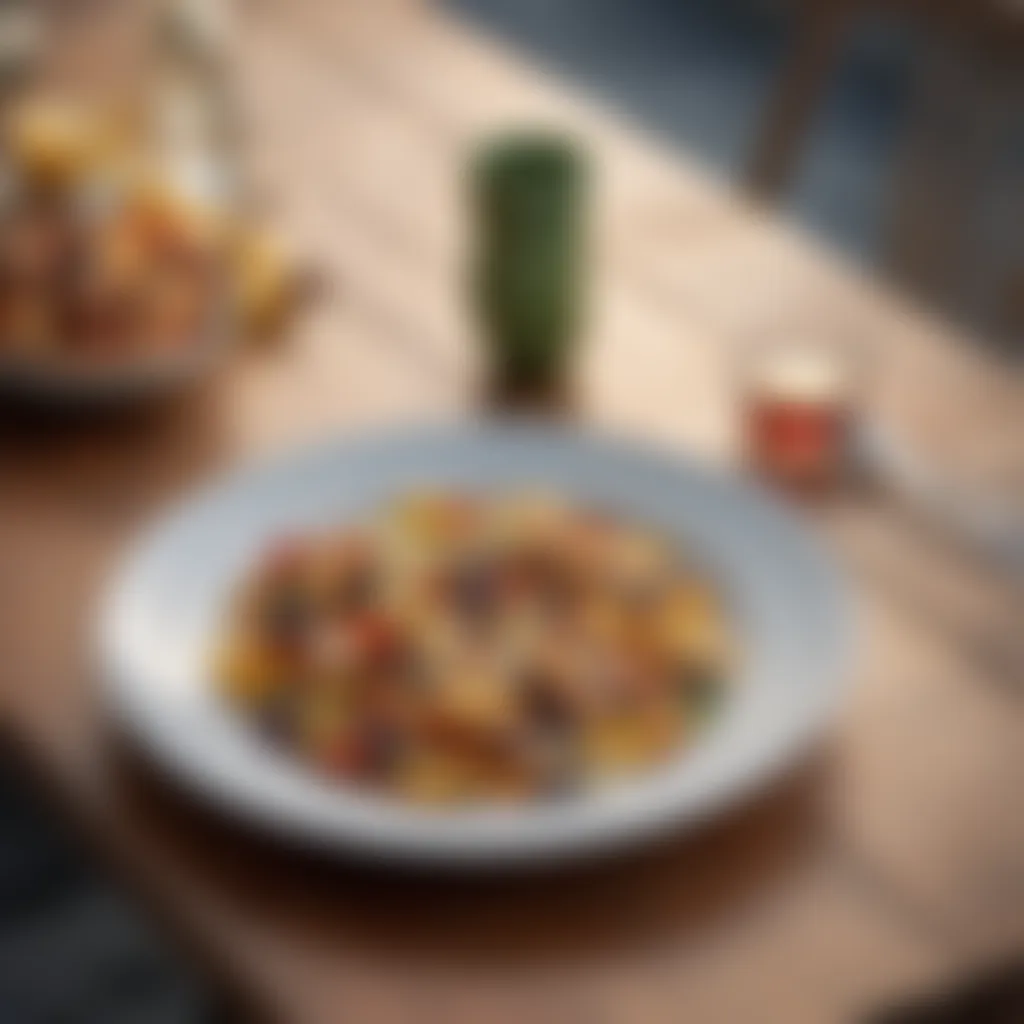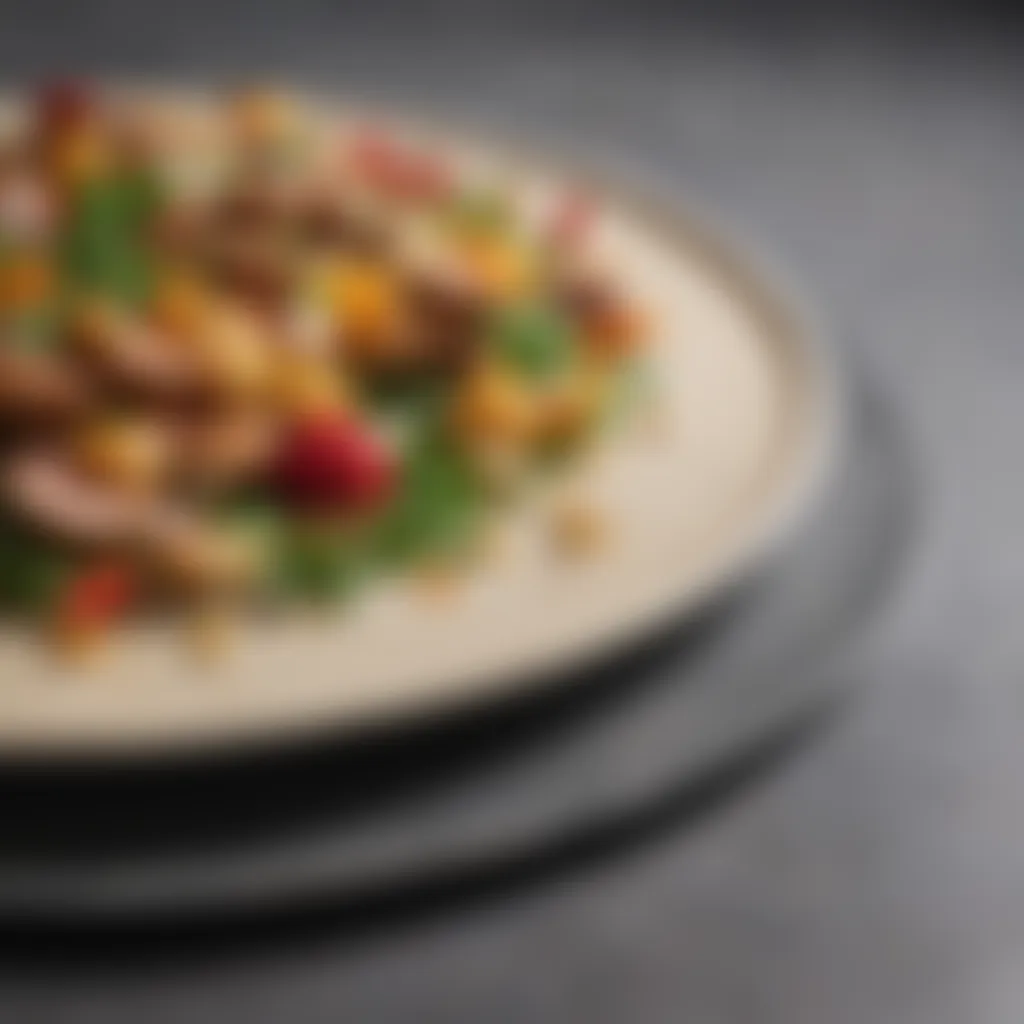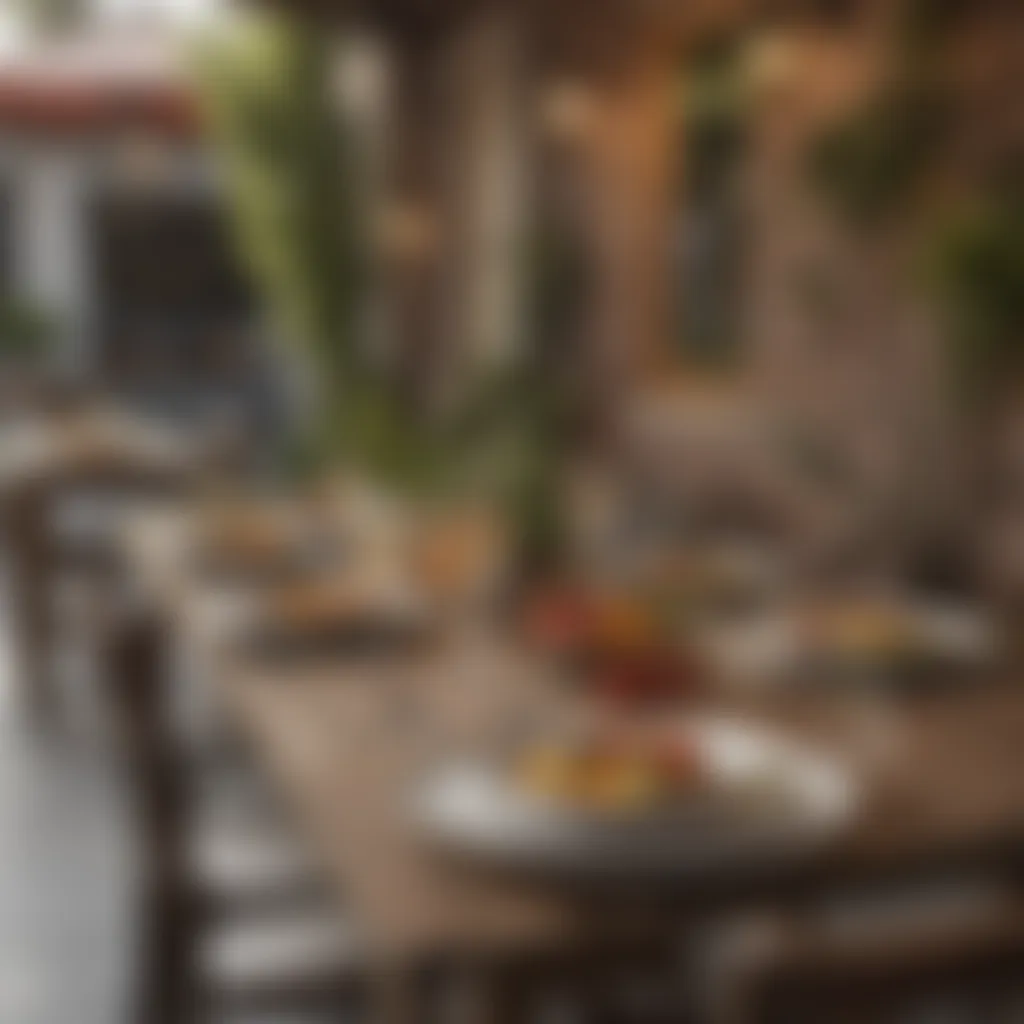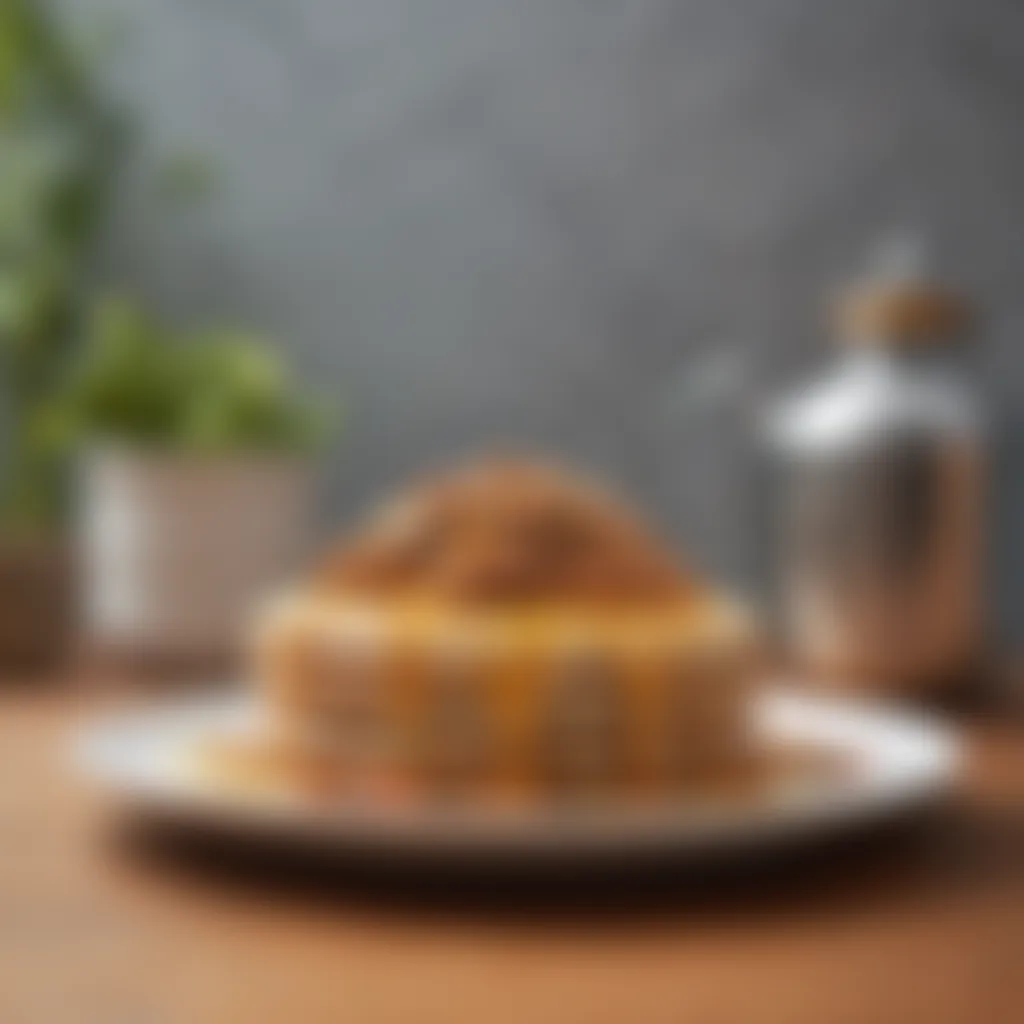Exploring Patio Plates: Design, Functionality, and Trends


Intro
In the realm of outdoor dining, the choice of patio plates plays a significant role. Patio plates are not mere vessels for food; they reflect both aesthetic sensibility and functional requirements. This guide explores the intricate aspects tied to patio plates, emphasizing their design, materials, and functionality. As the outdoor dining trend gains traction, understanding these elements becomes crucial for creating an enjoyable experience.
Choosing the appropriate patio plate involves considering various factors such as durability, style, and ease of maintenance. With the growing emphasis on outdoor spaces, it is essential to align one’s selection with both the environment and personal taste. Each patio plate brings its own character and can drastically affect the overall ambiance of a meal outdoors.
Foreword to Patio Plates
Patio plates serve as an essential element in enhancing the outdoor dining experience. They not only provide functionality but also contribute to the overall aesthetic appeal of an outdoor setting. Choosing the right patio plates can make a significant difference in how meals are presented and enjoyed in open-air environments.
Understanding the materials, designs, and potential use cases of patio plates is crucial for anyone looking to elevate their outdoor dining. The right choice can reflect personal style while ensuring practicality. For instance, different materials such as ceramic or melamine offer unique benefits and considerations, aligning with various climate conditions and occasions.
Another vital aspect is the design element. Selecting the appropriate shape and color can influence the mood of a gathering. Are you hosting a casual barbecue or an elegant dinner party? Each occasion may call for different aesthetics, requires thoughtfulness.
Moreover, trends in outdoor dining change over time, influenced by consumer preferences and environmental awareness. Therefore, staying informed about the latest styles and sustainable options is essential.
In this article, we will explore the multifaceted world of patio plates, discussing their materials, designs, functionalities, and the implications they carry for outdoor dining. By the end, readers will have a comprehensive understanding of how to select patio plates that not only meet their needs but also align with contemporary trends.
Understanding the Materials of Patio Plates
Understanding the materials of patio plates is essential for those who want to enhance their outdoor dining experience. The choice of material influences not just aesthetics but also functionality and durability. Each material offers unique benefits and drawbacks, making it crucial to consider factors like weight, heat resistance, and maintenance needs.
Ceramic Patio Plates
Ceramic plates are a popular choice for outdoor dining. They are known for their elegance and variety of designs. Ceramic can withstand high temperatures, making them suitable for serving hot food or drinks. However, they tend to be heavier and can break if dropped. To maintain their appearance, gentle cleaning is advised, and they may require careful handling. While ceramics can be somewhat more expensive, their longevity adds overall value.
Melamine Plates
Melamine plates serve as a practical alternative for outdoor environments. Made from a durable plastic-like material, they resist shattering, making them ideal for families with children or during casual gatherings. Melamine is lightweight and easy to clean, often being dishwasher-safe. On the downside, melamine does not hold up well against high temperatures, so they should not be used in microwaves. Choosing high-quality melamine can enhance durability, ensuring they last multiple seasons.
Glass Options
Glass patio plates bring a touch of sophistication to outdoor dining. They are available in various styles, including tempered glass that is more resistant to breakage. Glass is non-porous, making it easy to clean and resistant to staining. However, they are generally heavier and can shatter under impact, posing a safety risk. When storing glass plates, ensure a secure location to avoid breakage. For outdoor settings, using tempered options is advisable for safety and durability.
Bamboo and Eco-friendly Materials
As sustainability becomes a priority, bamboo and other eco-friendly materials are gaining popularity. Bamboo plates are lightweight, biodegradable, and compostable. They are perfect for those who intend to minimize their environmental footprint. The unique grain of bamboo gives it an aesthetic charm. However, they require careful maintenance to avoid moisture damage. Regular oiling can help preserve their quality. Other eco-friendly options, like palm leaf plates, are also available, emphasizing environmental responsibility.
In summary, the choice of material in patio plates significantly affects both functionality and aesthetic value. Understanding these materials helps consumers select plates that best fit their dining preferences, lifestyle, and environmental values.
Design Considerations
Design considerations play a pivotal role in selecting patio plates, serving not only as a matter of aesthetics but also functionality. Outdoor dining often demands items that must withstand various weather conditions, while also enhancing the visual appeal of the space. A well-designed patio plate could elevate not just the meals served but also the overall dining experience. Consideration of size, shape, color, and versatility can guide choices that meet both practical needs and personal style.
Shape and Size Variations
The shape and size of patio plates impact both their usability and aesthetics. Round plates are classic and easily stackable, making them a staple in many households. On the other hand, square and rectangular plates often bring a modern twist, allowing for creative presentations. The size also affects how much food can be served. Larger plates may look appealing, yet smaller plates help control portion sizes, which can be particularly beneficial when serving multiple courses.
In selecting the right shape and size, think about the type of meals you intend to serve. For instance, a large barbecue gathering may benefit from larger platters, while a cozy dinner might do well with medium-sized plates that allow for variety without overwhelming the table.
Color and Pattern Trends
The color and pattern of patio plates significantly influence the ambiance of the outdoor dining setting. Neutral colors like white or beige provide a clean background, allowing food to take the spotlight. Meanwhile, vibrant colors or patterned plates can add energy to the atmosphere. Consider trends that change with seasons—bold oranges and browns in the autumn complement Thanksgiving meals, while lighter pastel hues in spring capture the freshness of outdoor picnics.


Patterns can also reflect personal style or thematic events. Floral designs work well for spring gatherings, while geometric shapes can suit modern tastes. It’s useful to think about how these colors and patterns interact with the surrounding decor and furniture to create a cohesive look.
Versatile Designs for Various Settings
Versatility in design is an essential element when choosing patio plates. With diverse occasions—ranging from casual barbecues to formal outdoor dinners—having plates that suit each setting can elevate the overall experience. Look for designs that can transition seamlessly from informal to formal. For example, plates that are simple in design yet elegant can be dressed up with stylish table linens for a celebratory dinner or used plainly for everyday meals.
Multi-purpose plates that can accommodate various food types also enhance their functionality. For example, combining shallow edges for pasta or salads and wider surfaces for meats ensures you make effective use of each piece. Smart choices in plate design ultimately contribute to simpler serving and enhance the enjoyment of your dining experience outdoors.
Functionality and Use Cases
Understanding the functionality and use cases of patio plates is crucial in optimizing outdoor dining experiences. These plates are not merely aesthetic choices; they also serve significant practical purposes. The right patio plates should complement the outdoor environment while being suited for various dining styles and serveware requirements. Functionality encompasses a diverse range of factors including easy handling, temperature insulation, and the ability to endure outdoor conditions.
Patio Plates for Outdoor Dining
Patio plates are designed with outdoor dining in mind. The materials chosen can influence temperature control, preventing food from cooling too quickly during a summer gathering. For instance, melamine is lightweight and resistant to breakage, making it a popular choice for families or those who frequently host get-togethers. These plates often come in vibrant colors and patterns, appealing to a wide range of tastes while also promoting a festive atmosphere.
Additionally, the size of the plates plays a vital role in outdoor dining. Larger plates are ideal for barbecues or buffet-style serving, accommodating generous portions of food. In contrast, smaller plates may be more suitable for appetizers or side dishes. Whatever the choice, patio plates can enhance the outdoor dining experience by providing both functionality and style.
Serving Versatility
Another benefit of patio plates is their serving versatility. Many plates come with compartments that help separate different food items, which is beneficial for those who prefer not to mix flavors. Moreover, some patio plates are microwave and dishwasher safe, providing convenience for meal preparation and cleanup. It is essential to consider how the plates will be used across different occasions—be it a casual family meal, a picnic, or a formal garden party.
By investing in versatile options, you empower yourself to use your patio plates for various settings, thus enhancing their value.
Durability and Longevity
Durability is a key factor when selecting patio plates. Outdoor dining presents unique challenges, such as exposure to sun and wind, which can fade colors and warp materials over time. Therefore, opting for high-quality materials like certain ceramics or durable plastics can ensure that the plates withstand the elements.
It's essential to regularly check for any signs of wear or damage, as a compromised plate may not only fail in functionality but could also present safety hazards. Caring for your patio plates properly will promote their longevity, ensuring that they can be used for multiple seasons. Regular cleaning and proper storage are vital components of this aspect.
In summary, focusing on functionality and use cases will ensure that your patio plates meet both your aesthetic desires and practical needs, creating a pleasant environment for outdoor dining.
Maintenance of Patio Plates
Proper maintenance of patio plates is essential, not just for their longevity, but also for ensuring a pleasant dining experience. In outdoor settings, these plates often face challenges like exposure to the elements, stains from food, and wear from frequent use. By investing time in maintenance, you ensure that your patio plates not only look good but also serve their practical purpose effectively.
Cleaning Techniques
Cleaning patio plates involves more than just a quick rinse. Here are some effective techniques:
- Soaking: For tough stains like barbecue sauce or red wine, soaking the plates in warm soapy water can be beneficial. This helps to loosen dirt and grime, making it easier to clean.
- Dishwasher Use: Many modern patio plates, especially those made from melamine or glass, are dishwasher safe. Follow the manufacturer's instructions, and ensure that plates are loaded securely to avoid chipping.
- Non-Abrasive Cleaners: When cleaning ceramic or glass plates, use non-abrasive sponges or cloths. This helps to avoid scratches that can mar the surface.
"Regular maintenance not only preserves the aesthetic appeal of patio plates but also ensures they are safe for food consumption."
Storage Recommendations
Storing patio plates properly can significantly affect their lifespan. Here are some key points to consider:


- Stacking: If possible, stack plates with a paper towel or cloth in between each one to avoid scratching. Ensure they are stable when stacked to prevent tipping over.
- Climate Considerations: Avoid storing plates in damp areas, as moisture can lead to mold or mildew on some materials, particularly natural ones like bamboo.
- Use of Covers: If your patio plates are kept outside, consider using covers or dedicated storage boxes to protect them from dust and debris.
Repair and Replacement
Over time, even the best-maintained patio plates may require some attention. Here's what to think about:
- Chips and Cracks: For minor chips in ceramic plates, food-safe epoxy can provide a temporary fix. If a plate is cracked significantly, it is usually best to replace it to avoid potential hazards in food safety.
- When to Replace: Signs that indicate it’s time for new plates include persistent staining, fading colors, or significant surface wear.
- Choosing Quality: Invest in high-quality materials from reputable brands. This not only improves longevity but often enhances the aesthetic appeal of your outdoor dining experience.
By keeping these maintenance practices in mind, you can enjoy your patio plates for many social gatherings and family meals.
Environmental Impact
The environmental impact of patio plates is an aspect that cannot be overlooked in today’s context of increasing ecological concerns. Consumers are more aware than ever of how their choices affect the planet. Choosing patio plates involves considering several factors that can influence sustainability and ecological footprints. This section aims to shed light on the importance of material choices and recyclability in patio plate production and usage.
Sustainability in Material Choices
When it comes to sustainability, the choice of materials used in patio plates plays a critical role. Eco-friendly options are gaining traction as more manufacturers prioritize reducing waste and utilizing sustainable resources. Common materials such as bamboo, recycled plastics, and natural fibers are among the frontrunners in sustainability.
- Bamboo Plates: These are biodegradable and grow quickly without the need for pesticides. The cultivation of bamboo supports biodiversity and helps decrease carbon emissions.
- Recycled Plastics: This material diverts waste from landfills and reduces reliance on new plastic production. Products made of recycled plastic can often be designed to mimic the appearance of ceramic or melamine, offering aesthetic appeal without the environmental cost.
- Natural Fibers: Materials like palm leaves provide a unique and rustic look. They are also naturally disposable, breaking down without leaving harmful residues.
Selecting materials that are sustainable is not only beneficial for the environment but can also reflect positively on a consumer’s lifestyle choices. The shift towards eco-friendly patio plates aligns with growing trends in responsible consumption.
Recyclability of Patio Plates
Recyclability is another significant aspect to consider. Not all patio plates are created equal when it comes to their end-of-life process. Understanding what can be recycled helps consumers make informed choices, which ultimately supports a circular economy.
- Ceramic Plates: While durable, typical ceramic plates can be challenging to recycle. However, some facilities accept broken ceramic for repurposing.
- Melamine Plates: These plates are not widely recyclable due to their composition. They can be durable for use but may contribute to landfill waste if discarded ultimately.
- Glass Plates: Glass is one of the most recyclable materials. It can be remelted and formed into new products without losing quality, making it a favorable choice for environmentally conscious consumers.
"Sustainability is not a trend; it is a responsibility that consumers must take seriously when choosing products for their homes."
Innovations in Patio Plate Design
Innovations in patio plate design play a crucial role in enhancing the user experience, adaptability, and overall functionality. As outdoor dining grows in popularity, the need for versatile, practical, and aesthetically pleasing patio plates has become evident. Each innovation aims to balance style with functionality, making them more suited for varied needs and settings.
Smart Features
The integration of technology into patio plates represents a significant leap in innovation. Smart features can include temperature control, allowing plates to maintain a specific temperature for longer. Some plates might even have embedded sensors that notify users when food is ready to be served or needs to be refreshed. These features can elevate the dining experience, especially in outdoor settings where temperature control is more challenging.
Moreover, connected design enables users to monitor food temperatures through smartphones. This is particularly useful for housewives who often host gatherings. Utilizing these plates can enhance the quality of the meals served, ensuring guests enjoy food at the ideal temperature.
In addition to temperature regulation, certain patio plates are being designed with spill-proof edges that minimize mess, making them more convenient for families with kids or pets. This blend of functionality and usability is becoming a trend worth considering when selecting patio plates.
Adaptive Designs for Seasonal Use
Adaptive designs cater to the varying needs and tastes of consumers throughout the year. Patio plates with seasonal themes are growing in popularity. For instance, during summer barbecues, plates with vibrant colors and tropical patterns tend to be favored, while holiday gatherings may call for plates featuring classic winter motifs or earthy tones.
These designs can easily shift to accommodate various themes without sacrificing quality or durability. Households can opt for plates that reflect environmental changes or festivities, thus enhancing the atmosphere as well.


Moreover, the adaptability of sizes and shapes among patio plates allows for unique presentations. Larger plates may be used for parties, while smaller, individual servings can be great for intimate meals. The flexibility in design helps cater to different occasions and user preferences, making it vital for homeowners and chefs.
technology and adaptability which addresses the practical aspects of outdoor dining while allowing for individual expression through design. As trends evolve, consumers should consider how these innovations can enhance their own digital experiences at the dining table.
Consumer Trends and Preferences
Understanding consumer trends and preferences regarding patio plates is essential for anyone looking to enhance their outdoor dining experience. This section explores how modern consumers prioritize functionality while also seeking aesthetic appeal. With an increase in outdoor living spaces, the demand for patio plates has evolved, taking into account various factors such as style, durability, and sustainability. The choices consumers make impact not just their personal enjoyment but also trends within the marketplace, affecting future designs and innovations.
Popular Brands in the Market
Several brands have gained recognition for their quality and innovation in patio plates. Brands like Corelle, known for their durable glass designs, are popular due to lightweight and chip-resistant plates. Mikasa offers elegant ceramic options that appeal to those wanting a more classic touch. On the other hand, Cambridge Outdoor focuses on eco-friendly materials, attracting environmentally-conscious consumers. Each of these brands brings unique strengths, influencing buyer choices based on personal values and dining aesthetics.
- Corelle: Offers practical and stylish options.
- Mikasa: Known for elegance in outdoor dining.
- Cambridge Outdoor: Focuses on sustainability.
Consumer preferences often lead to increased market competition, encouraging brands to push the limits of their offerings. To make an informed choice, it is important to investigate the characteristics of each brand's products.
Consumer Feedback and Reviews
Feedback from consumers provides valuable insights into the performance and satisfaction levels of patio plates. Reviews often highlight aspects such as durability, design versatility, and ease of maintenance. Many housewives appreciate the practicality of patio plates that can withstand outdoor conditions while still presenting beautifully.
- Durability: Customers consistently seek plates that resist breakage and scratches. Outdoor dining can be casual and messy, so resilience is a key factor.
- Design Variety: Preferences vary widely, from classic patterns to bold colors, reflecting personal style and trends.
- Care Instructions: Consumers frequently mention ease of cleaning and storage, which directly influences their decision.
"Patio plates should not only serve a purpose but also enhance my outdoor gatherings with beauty and ease."
Consumer reviews can guide potential buyers by revealing strengths and weaknesses that may not be apparent from product descriptions alone. Many housewives share their experiences online, contributing to a community of informed decision-making. Therefore, reading feedback becomes a critical step in the selection process, ensuring satisfaction with both style and functionality.
In summary, as consumer preferences shape the patio plate market, understanding which brands lead and how consumer feedback influences buying decisions becomes invaluable. This knowledge not only aids in personal selection but also reflects broader trends that will continue to evolve.
End: The Future of Patio Plates
The future of patio plates is an essential aspect of the outdoor dining experience. With evolving consumer preferences and a growing focus on sustainable living, the design and functionality of patio plates will undergo significant changes. This section summarizes the critical trends and elements shaping the future landscape of patio tableware.
Evolving Trends
The market is witnessing a shift towards more sustainable options. Consumers increasingly prioritize eco-friendly materials. This includes plates made from recycled or biodegradable materials. Brands are leveraging innovation to offer not just aesthetic appeal but also functionality in their designs. For instance, plates that are microwave-safe and dishwasher-friendly are gaining popularity.
Key Trends Include:
- Sustainable Materials: Plates made from bamboo, recycled plastics, or biodegradable options are becoming more prevalent.
- Smart Features: Integration of technology in outdoor dining, such as plates with temperature indicators to show food freshness or heat levels.
- Customizable Designs: The rise of personalized outdoor dining experiences is encouraging brands to offer customizable plate designs that reflect the homeowner's personal style.
- Multi-functionality: Plates that serve dual purposes, such as serving and storing, are appealing to consumers looking for practicality.
Final Thoughts on Selection
Choosing the right patio plates requires consideration of various factors. Durability should be a priority to withstand outdoor conditions. However, this should not come at the expense of aesthetic appeal. The ability to easily clean and maintain the patio plates will influence the selection process.
In summary, selecting patio plates combines aesthetic choices with practical necessities.
Consider These Factors When Choosing:
- Material: Choose between ceramic, melamine, or eco-friendly options depending on usage and aesthetics.
- Design: Opt for colors and patterns that complement your outdoor space, while considering how they align with current trends.
- Functionality: Ensure the plates meet your needs, whether for family meals or larger gatherings.
"The right patio plate can enhance not only the visual appeal of your outdoor dining but also the practical experience of dining outdoors."
Understanding these considerations will enhance your overall outdoor dining experience, ensuring that the choices made today lead to satisfaction in the future.







